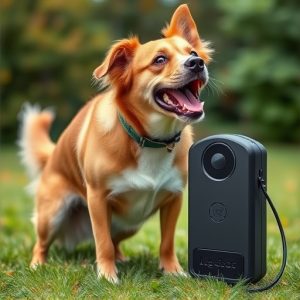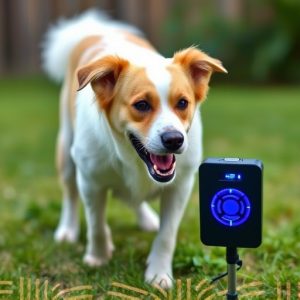Sonic Repellents: Training Aggressive Dogs with Innovative Control Systems
Sonic repellents offer a humane, effective solution for managing aggressive dog behavior, using high…….
Sonic repellents offer a humane, effective solution for managing aggressive dog behavior, using high-frequency sound waves that target animals' hearing without causing harm. Ideal for dog owners, these devices provide a remote and continuous alternative to chemicals or invasive training methods, with adjustable settings for different behaviors. Despite potential challenges like animal habituation and weather impacts, sonic systems remain a safe and environmentally friendly option for controlling unwanted animals, ensuring peace of mind and pet safety through specific frequency tailoring.
Animal control sonic repellent systems offer a non-lethal approach to managing aggressive pet behavior. This article delves into the science behind sonic repelents, exploring their effectiveness in targeting specific dog behaviors. We examine various modes of operation, highlighting benefits and limitations, and provide practical tips for implementation. Discover how these innovative systems can help train your pets without resorting to traditional, potentially harmful methods, especially focusing on addressing aggressive tendencies in dogs.
- Understanding Sonic Repellents: How They Work
- Dog Repellent Modes: Targeting Aggressive Behavior
- Benefits and Limitations of Sonic Animal Control Systems
- Implementing the System: Tips for Effective Use
Understanding Sonic Repellents: How They Work
Sonic repellents are an innovative solution for managing and controlling animal behavior, particularly in dealing with aggressive pets like dogs. These devices operate by emitting high-frequency sound waves that target the animal’s sense of hearing. Unlike traditional repellents that rely on scent or spray, sonic technology offers a non-toxic and humane approach to deterring unwanted wildlife or domestic animals. The principle behind it is simple: certain frequencies can create an unpleasant sensation in the animal, encouraging them to stay away from the treated area.
For dog owners dealing with aggressive behavior, sonic repellents can be a game-changer. Instead of relying on dog repellent modes that may involve invasive chemicals or training methods, this technology provides a remote and continuous solution. The sound waves are designed to be inaudible to humans, ensuring comfort for both the pet owner and surrounding neighbors. By targeting specific frequencies that resonate with dogs, these systems can effectively change their behavior without causing harm.
Dog Repellent Modes: Targeting Aggressive Behavior
When it comes to dog repellent modes, addressing aggressive behavior in pets requires tailored solutions. Modern sonic repellent systems offer a non-lethal and humane approach by utilizing ultrasonic sounds that are unpleasant to dogs but harmless to humans and other animals. These devices can be programmed to emit specific frequencies targeted at different types of aggressive behaviors, such as barking, growling, or charging.
For dog owners dealing with aggressive pets, understanding the various repellent modes is key. By adjusting the settings, these sonic systems can help mitigate problematic behavior effectively. For instance, a mode focusing on high-frequency sounds can deter dogs from approaching certain areas, while another mode might target specific vocalizations to calm down an aggressive dog. This versatility ensures that pet owners have a dynamic tool at their disposal, providing a safe and effective way to manage their pets’ behavior in diverse environments.
Benefits and Limitations of Sonic Animal Control Systems
Sonic animal control systems offer a non-lethal and humane approach to keeping unwanted animals away from residential or commercial areas. One of the key benefits is their versatility; these devices can be tailored to specific needs by adjusting frequency ranges, which allows for different dog repellent modes suitable for aggressive pets. They are effective in repelling a wide range of animals, including dogs, cats, and rodents, without causing harm. The technology works by emitting high-frequency sounds that are unpleasant to animals but generally inaudible to humans, ensuring safety and minimal disturbance to neighbors.
However, there are limitations to consider. Sonic repellent systems might not be as effective in dense populations or areas with significant background noise, as the sounds can get masked. Additionally, weather conditions like rain or strong winds could potentially reduce their performance. Some animals may also become accustomed to the sound over time, requiring regular adjustments or alternative repellents. Despite these challenges, sonic control systems provide a safe and environmentally friendly solution for managing animal infestations, making them a viable option for many property owners.
Implementing the System: Tips for Effective Use
Implementing an animal control sonic repellent system involves a strategic approach to ensure its effectiveness, especially when dealing with aggressive pets like dogs. Firstly, identify the specific areas where the animals are causing disturbances, such as entry points or feeding zones. Position the devices at these hotspots to disrupt their behavior patterns directly. The system typically offers various dog repellent modes, allowing you to customize the settings according to the pet’s temperament and your needs. For aggressive dogs, consider using higher frequency settings that humans cannot perceive but are irritating to animals, ensuring minimal discomfort for bystanders.
Regular maintenance is key to keeping these devices efficient. Check the batteries frequently, as weak or dead batteries might render the system ineffective. Keep the sensors clean and free from debris, insects, or plant growth, which could obstruct their view and reduce sensitivity. Additionally, test the system periodically to confirm its range and effectiveness, allowing you to make adjustments if needed, especially in larger areas with multiple entry points.
Sonic animal control systems, particularly those designed for dog repellent modes, offer a non-lethal and humane way to address aggressive pet behavior. By leveraging high-frequency sound waves, these devices can effectively deter animals without causing harm. However, they have limitations, such as variability in effectiveness based on environmental factors and potential sensitivity in humans. For best results with Dog Repellent Modes for Aggressive Pets, proper implementation is key. This includes strategic placement, understanding animal behavior, and consistent use. With the right approach, sonic repelents can be a game-changer in managing problematic pet aggression.


